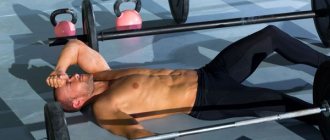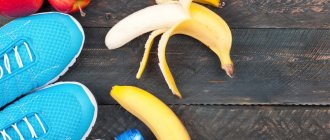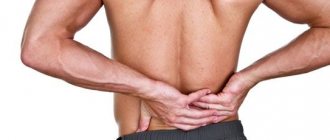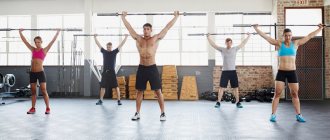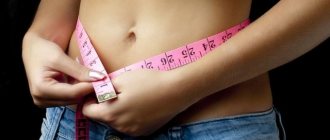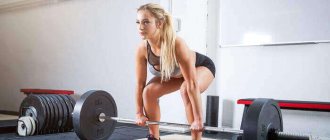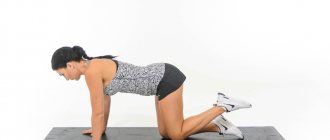Muscle pain is almost always considered a sign of a well-executed workout - both immediately during and the next day. No pain no gain is the motto of a real rocking chair. And there is some truth in this: to get what you don’t have, you need to leave your comfort zone, and leaving your comfort zone is always stressful and unpleasant.
But beginners don’t always understand what needs to be tolerated and what not. Pain comes in different forms, some are beneficial, others are harmful, so it is better to learn to distinguish one from the other.
Types of muscle pain
- Moderate muscle pain.
Occurs immediately after classes. Its appearance is explained by microtraumas and excess lactic acid in the muscles. This muscle pain is quite mild. - Delayed muscle pain
. Muscles begin to ache a few days after exercise, most often on the second day. This severe muscle pain prevents the muscle from contracting fully. It usually occurs with very intense training in beginners without a period of adaptation to the load, as well as with too much emphasis on eccentric loads (muscle stretching when lowering weights). - Muscle pain from injury.
First sharp, then aching, constraining, aggravated by the slightest load or sudden movement. In addition, it may be accompanied by swelling and hyperemia of the damaged area. Regardless of the nature of the injury, in such cases it is necessary to consult a doctor. The most serious injuries characterized by this type of pain are muscle rupture, nerve compression, joint damage, etc.
Pain during exercise
Pain from stretching a muscle under load
This occurs when a muscle is stretched by weight. For example, stretched glutes and hamstrings in the Romanian deadlift. This is a dispersed pain throughout the muscle, as if it is “tearing off” from the bone (figuratively speaking). Moderate sensations are normal. Moreover, it is assumed that controlled stretching of the muscle under load is one of the additional stimuli for muscle growth. Therefore, there is even a separate type of training based on “negatives”, when the phase of stretching the muscle under weight is deliberately long.
Pain-burning during exercise
A strong burning sensation in the muscle appears when it is under load for a long time, that is, 12 repetitions or more. Somewhere in the middle of the exercise, a burning sensation appears, and then from repetition to repetition it grows until it becomes so unbearable that it is impossible to continue.
Oxygen stops flowing to muscle cells; they are acidified by the breakdown products of the main muscle fuel during training - glucose. This chemical poisoning is also one of the stimuli for muscle growth, so training until the burning sensation is effective (although there is little pleasure in it).
Joint pain
Another type of pain during exercise is a sharp, needle-like pain in the joint that quickly increases from repetition to repetition. Many people train through pain, using bandages, orthoses, bandages, warming and pain-relieving ointments. But pain is a signal that it is dangerous to continue moving.
Pain in the joint (and probable injury in the future, as a consequence) can be caused by non-compliance with the technique, potentially dangerous and simply unnatural exercises for the joints, incomplete recovery of not only muscles, but also connective tissue between workouts, poor warming up before training, and poor posture. and incorrect joint position.
How to get rid of muscle pain?
Muscle pain from training, including in the legs, is a transient phenomenon. And it’s easy to deal with by following a few rules.
- Balanced diet.
The body of a person engaged in training must necessarily receive proteins, carbohydrates and fats. The calorie content of dishes directly depends on the metabolic rate, health status and training goals. If there is a lack of nutrients, the body will not be able to fully recover after exercise. - Drinking regime.
Getting enough water into the body helps eliminate toxins that negatively affect muscle recovery after intense physical activity. - Contrast shower and cold compresses.
They help eliminate muscle pain and fatigue. It is worth considering that a contrast shower involves alternating cool and warm water, rather than hot and ice. - Massage.
Helps improve blood circulation, resulting in more oxygen and nutrients entering the tissues, and at the same time, toxins are more actively eliminated. - A complete night's rest.
Eight hours of sleep is an essential part of every athlete’s daily routine. Otherwise, the body will have an increased level of cortisol, which will negatively affect the recovery of the body and the intensity of muscle pain, which will only increase. - Competent approach to classes
. It includes a thorough warm-up, proper execution of all exercises, and a balanced training regimen. Rehabilitation exercises after the onset of pain include exercise on an exercise bike and long-distance running.
Up to contents
Absence of muscle pain and its effect on the result
Many people draw a parallel between soreness and muscle growth. The logic is simple - if muscles hurt after training, it means they are growing.
But our body is not as simple as we would like.
Scientists have long proven that soreness is not a guarantee of increasing muscle volume.
Moreover, severe post-workout pain means severe damage. And this lengthens the recovery period and, accordingly, slows down muscle growth! Read more about this mechanism here.
In general, asking the question of why muscles don’t hurt after training is fundamentally wrong!
Answer yourself - why do you go to the gym - to constantly suffer from sore throat or to increase muscle mass and strength?
Many beginners, without noticing it themselves, incorrectly set evaluation criteria for the effectiveness of strength training :
- If you came to the gym to increase your muscles, then your main criterion is an increase in body weight (determined by weighing) and an increase in muscle volume (measurements with a centimeter tape)
- If you are training for relief, then this means reducing body weight and the percentage of subcutaneous fat (you can find out how to determine your fat level here)
- If your goal is strength, then the effectiveness of exercise is determined by the rate of increase in strength indicators.
All of these parameters are objective indicators of progress that can be measured, weighed and recorded. And it is simply impossible to determine the level of progress by soreness!
Post-workout muscle soreness is not an indicator of performance gains. The only thing it indicates is the degree of stress on the muscles. The more they hurt during rest, the more stress they received during training.
Methods for reducing pain
These methods of combating sore throat have long been known and are widely used both in Olympic sports and in bodybuilding:
- Bath or sauna – once a week
A remedy that quickly and pleasantly relieves muscle hypertonicity and relieves soreness.
- Hot bath or shower after every workout
A relatively good method, as an alternative to a bath. Used as a preventive measure after shock loading.
It is believed that a hot bath relieves severe pain by about 70%.
- Massage or self-massage – 2-3 times a week
Another effective and pleasant way to combat sore throat. For self-massage, special rollers, tennis balls and massage guns are used.
- Warming ointments – 2-3 times a day
They have a relatively weak effect and are used as an additional remedy to the above.
- Light stretching – 3-5 times a day
Light stretching helps to combat muscle pain quite well. However, the method is quite painful and there is a risk of injury if you overdo it.
You need to stretch after a preliminary warm-up, without sudden movements and strong pressure.
- Physiotherapy (electrophoresis, magnetotherapy, inductothermy, etc.)
For most ordinary gym goers, these are exotic methods of fighting. But if you have the opportunity to use them, be sure to use them.
In professional sports, physiotherapy has proven a positive effect on accelerating recovery after high-impact competitive loads.
Is it possible to train with sore throat?
There is a strong opinion that if a sore throat appears the next day, you must definitely exercise to get rid of it.
This method is indeed practiced in many elite sports. After a high-impact workout, the next day is planned for light, tonic activity.
BRIEFLY ON THE TOPIC:
The goal of toning training is to speed up recovery. Light exercise increases blood circulation, which helps reduce the level of pain (if any) after impact exercise.
However, this rule applies to weak and moderate degrees of soreness. If you have strong, painful sensations, it is not recommended to train. Since repeated exercise can, on the contrary, slow down recovery.
Imagine that you have severely cut your finger (severe soreness). The subsequent training is like you want to deliberately cut it even more, in the hope that the wound will heal faster.
This is stupid, but this is exactly what many people do when they have severe pain after exercise.
In this case, it is necessary to use other methods to reduce discomfort, and not prevent muscles from growing with unnecessary loads during this period.
Delayed pain
It occurs 2-3 days after the end of training. If the muscles are stretched or contracted, the pain will be severe. Discomfort appears after changes in training, during a long break, and among beginners.
Severe aching and persistent pain is considered evidence that the load is severe. The athlete lifts much more weight than is appropriate for his level of training. It is necessary to increase the load gradually. This ensures strengthening and adaptation of joints, muscles, ligaments, and the nervous system.
When the muscles have not yet fully recovered before the next session, you need to conduct a recovery session. You don’t have to change the exercises, but reduce the weight by half. If you reduce sets of 15-20 repetitions each, the painful muscle receives more blood, which is necessary to improve circulation and supply it with the nutritional components needed for recovery.
Mechanical hypothesis
The mechanical hypothesis states that the main cause of muscle damage and, accordingly, the appearance of soreness is eccentric muscle movements.
What is eccentric muscle movement? There are three types of muscle work: concentric , isometric and eccentric . And notice that we use the word "job" and not "cut."
Concentric muscle work
During the concentric movement, the muscle shortens, and only then does it actually contract. The muscle shortens when lifting something, or during movement of the part of the body for which it is responsible.
- Example: the ascending phase of a squat or bench press.
Isometric muscle work
During isometric work, the muscle does not change in length.
- Example: plank or trying to hold the weight at the peak point (muscles tense, but no movement occurs).
The goal is to lose weight
Here we are already interested in active burning of calories, which is possible only under high loads. In this case, a complex of aerobic and anaerobic loads is considered, the first of which consists mainly of cardio load, and the second of strength. However, you may feel muscle pain for the first 2-3 weeks. After adaptation, if the desired result has not been achieved, the program changes, the loads increase, and therefore the pain resumes.
No pain, no gain - “No pain, no gain”
This is, of course, not true. As we have already found out, there are several factors that explain the absence of pain. It is important to understand that the training itself is not aimed at causing pain, but at developing individual muscle groups or the body as a whole. That is, if your training program gives high-quality results, but you do not feel pain, consider yourself lucky and do not rush to change this program in pursuit of an imaginary result.
Both in life and in sports, the most important and basic criterion for success is a clearly formulated goal. Based on this, there are some nuances that should also be taken into account.
Why muscles don't hurt with regular exercise
In the first training sessions, beginner athletes train with light weights and perform a small volume of load. But the next day they are overtaken by such a strong fever that they are afraid to move again.
Time passes and regular exercises lead to an increase in working weights and an increase in the training load by 2 or more times. At the same time, there is no soreness!
This paradox still has no clear answer.
There are several theories that try to explain at the biochemical level why trained athletes practically do not suffer from muscle pain. But they don't have enough evidence.
True, even experienced athletes from time to time experience sore throat after unusual, new loads for them. Their goal is to “shake up” the body and muscular system, giving impetus to progress.
But such painful sensations for advanced bodybuilders are the exception rather than the rule.
Causes
Pain is a reflection of the process during which the destruction of muscle structures is observed. During physical exercise, the myofibrils of muscle fibers are displaced, mitochondria are disintegrated, which causes the level of leukocytes in the blood to increase. This condition is observed with injuries, inflammation, and infections.
The destruction of muscle tissue fibers leads to the formation of protein fragments of molecules. Cells that digest damaged tissue are activated. They secrete products that cause pain. After destruction, muscle fibers release satellites, which provoke the formation of protein by the tissues.
What are stretches?
Stretching is “the application of force to muscle-tendon structures to change their length, usually to increase joint range of motion (ROM), reduce stiffness or soreness, or in preparation for physical activity” (3).
Although there are many types of stretching (Figure 1), static stretching appears to be the most common type of activity recommended after exercise. Urgent or long-term sprains are also distinguished. Acute stretching usually refers to single stretches of tissue for more or less than 30 seconds (4, 5). Long-term stretching refers to repeated stretching of tissue over several sets, days, or even weeks (6).
Should I worry if there is no pain?
Is it good or bad if there is no pain? The answer depends on the goals set for the person. The main ones:
- WEIGHT LOSS. When a person’s ultimate goal is to lose weight, then most likely he performs a complex of strength and cardio training. With this regimen, the muscles can hurt for up to three weeks, and then stop.
- BODY-BUILDING. If an athlete wants to significantly increase muscle mass, he will need to give 100%. It will be impossible to do this in every workout, simply because it is impossible to constantly be in this state of 100% focus and concentration. Even the pros are not capable of this, although the lion’s share of their hellish training takes place under the motto “either one more approach or die...”. If you train with the same attitude, then pain will become your faithful companion for a long time. From the very beginning, even with a small weight, it will be noticeable.
- KEEPING IN SHAPE. If you exercise to maintain physical fitness by jogging in the morning or visiting the gym several times a week, and your goal is to maintain muscle tone and the scales at the same level, and not change them, then pain is OPTIONAL for you.
Krepatura is an indicator of stress exposure
If you increase the weight, add more repetitions or sets, or use a new exercise, your muscles will be subjected to an unusual load. This is exactly what the body signals the next day!
First, all painful sensations are eliminated, and only after that the process of hypertrophy begins, that is, an increase in muscle volume.
It is believed that hypertrophy begins only after the pain passes. It turns out that if you train “on strength”, then you are blocking growth with your own hands.
In order not to slow down progress with excessive frequency of training, bodybuilding uses other methods of dealing with delayed muscle pain.
The goal is to be in good shape
In this case, we are not interested in constantly increasing the load, and therefore the question should not arise after how many workouts the muscles will stop hurting. Pain, if it is present, will only be at the beginning of training. Gradually, when the muscles get used to certain loads, they will stop hurting and will maintain their current state without development. If you don’t have a goal to change your body or adjust your shape, then such loads are quite enough to maintain tone and good mood.
A good option for exercise in this case would be Pilates, yoga and aerobics. These exercises develop all muscle groups well without overloading them or causing pain.
Interpretation of results
The authors did a great job analyzing 99 publications and comparing 10 post-training recovery techniques. Their analysis has three main limitations. First of all, an effective recovery technique does not guarantee that the workout will also be more effective. This circumstance may seem unexpected. It is known, however, that some recovery treatments, such as non-steroidal anti-inflammatory drugs or cold water immersion, while reducing soreness and inflammation, at the same time reduce muscle strength and slow muscle growth.
Secondly, the analysis does not consider combinations of techniques, with the exception of massage in combination with stretching, which, however, is quite understandable. If you include various combinations of techniques in the analysis, the data set will grow so large that it becomes unmanageable.
Finally, results from different studies are difficult to compare. This limitation is the most significant. Most of the articles included in the analysis described recovery from either running or jumping or eccentric training, but training protocols may vary in volume and progression. Presumably, the effects of recovery techniques would be more pronounced after particularly strenuous training that causes multiple damage to muscle fibers, which could lead to bias if, for example, most cases of the effect of stretching were studied after gentle training, but shapewear was used mainly after a series of strenuous exercises. It is likely that the analysis included studies that used the same recovery technique after different training regimens, but the potential for bias should be kept in mind.
The main practical conclusion from this analysis can be easily drawn by “not only adults, but even toddlers”: after a hard workout, it is useful to schedule a massage. It is superior to all other treatments in relieving long-term muscle soreness, fatigue, and even helps combat muscle damage and inflammation up to 72 hours after exercise. In all the described cases, the athlete went for a massage directly from the gym (hopefully through the shower), and it is unknown how effective this remedy will be the next day.
Despite all the advantages, massage has two undoubted disadvantages: it requires time and money. If one of these resources is lacking, choose shapewear. MASS reported a meta-analysis on this clothing, although it did not compare its effects to other restorative techniques. According to French researchers, shapewear ranks second in its ability to alleviate muscle pain and third in relieving fatigue, behind only massage and immersion.
The strong recovery has fallen short of expectations. Although it turned out to be one of the most effective methods of counteracting muscle pain, at the same time it increased fatigue after exercise. On average, this increase is small, but its value varies widely across studies. Stretching also failed to take a prize place on the efficiency podium. Although many people practice stretching and claim that it reduces post-workout soreness, scientific research has not confirmed its effect on either strength or fatigue.
And finally, immersion in cool water. A few years ago, Australian scientists showed that immersing yourself in a cold bath after strength training slows down muscle growth and strengthening. The athletes sat waist-deep in water for ten minutes at a temperature of about 10°C. However, the results of the meta-analysis suggest that immersion in water at any temperature below body temperature promotes recovery. Of course, you shouldn’t jump into an ice hole, but you can recover without damaging your muscles by immersing yourself in cool or warm water. The effect of the procedure may depend on what actually slows muscle growth: cold or immersion in water itself, regardless of temperature.
Treatments as varied as massage, shapewear, and water immersion have one thing in common—they all compress tissue to varying degrees, affecting blood flow to muscles and other parts of the body. The authors of the meta-analysis suggest that compression prevents swelling in the muscles and facilitates the elimination of waste and metabolic byproducts after exercise. Massage cleanses best because it doesn't compress the muscles for long and doesn't interfere with blood flow, tight clothing prevents swelling, and immersion in water balances both of these factors. According to MASS article author Greg Nukkolls, it would be interesting to study the long-term effects of these recovery methods on muscle growth and strength gains. If cold water immersion weakens muscles due to the act of immersion rather than the cold, then, theoretically, all three strategies could promote recovery but reduce adaptation to training. If restricting muscle blood flow is preventing muscle growth, massage will help with recovery, but shapewear is unlikely to do so. If muscle growth is hampered by the accelerated elimination of metabolic products, then massage in the long term is more likely to harm than help. Nukkols himself believes that muscle growth is affected by rapid cooling when an athlete is immersed in water, but this assumption needs to be tested.
Which muscles should ache after training?
Obviously those that your exercises were aimed at. That is, if, when lifting the barbell, your biceps and triceps hurt, then the exercise can be considered completed successfully, you have achieved the desired result. If, during the same exercise, a burning sensation occurs in the back area, you should immediately stop doing it. This means that the execution technique was not followed. Although sometimes a situation arises that a trainee, due to inexperience or lack of understanding, harms his health, much more often the cause of injury is negligence and neglect of safety precautions, which trainers tirelessly repeat in the gym.
Soreness after training: good or bad
Previously, it was believed that if a muscle hurts, it means it is growing. That is, the presence of strength was considered a prerequisite for growth.
However, both scientific research and the experience of bodybuilders have shown that there is no relationship between soreness and muscle growth. On the contrary, severe pain increases the recovery time of muscle tissue.
This in turn slows down and sometimes completely blocks the hypertrophy process.
It turns out that by training with excessive fanaticism, you significantly reduce the speed of your own progress!
